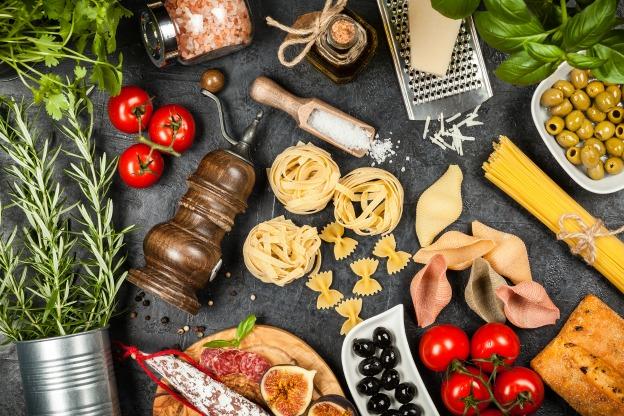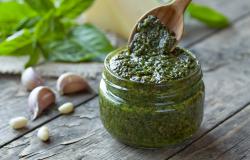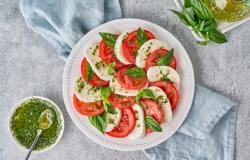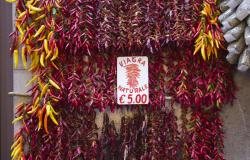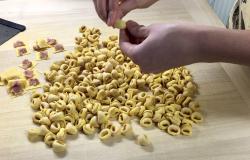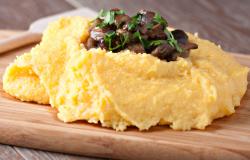If you love Italian food and you like preparing it at home, you will need a few staple ingredients, which are always handy to have in your pantry, whether you want to make a simple pasta al pomodoro, or fancier creations using the wonderful foods and flavors of Italian cuisine.
Extra virgin olive oil
Extra virgin olive oil, the king of all condiments, is by all means the most easily digested vegetable fat, and therefore suitable for people of all ages. Always go for extra virgin: it is the highest quality and most natural - virgin means the oil was made by simply pressing olives and extracting the juice. It is the only cooking oil that is made without the use of chemicals and industrial refining. Along with onion and garlic, extra virgin olive oil is the basis of sauces in Italian cuisine and often replaces animal fats of butter or lard. Its fruity, bitter, pungent taste add a delicious flavor to any dish, from pasta to meats, from seafood to vegetables.
Balsamic vinegar
Aceto balsamico has a variety of uses in the Italian kitchen, the most common being as a condiment for salads (along with olive oil and a pinch of salt); but that would be restrictive. Balsamic vinegar is also used on chunks of Parmigiano Reggiano, on risotto, on scaloppini, and even strawberries and gelato! Just make sure you buy traditional balsamic vinegar, which is only made in Modena and Reggio Emilia (it must be labeled Aceto Balsamico Tradizionale and carry a D.O.P. -Denominazione di Origine Protetta- stamp).
Spaghetti and pasta corta
Of course, pasta is a staple food of Italian cuisine and no Italian pantry can be called so if it doesn’t include spaghetti, an all-time favorite, and pasta corta, say penne, fusilli, tortiglioni, and many more. Pasta shapes are specifically designed to hold the sauce in the best way possible. Always prefer durum wheat pasta rather than soft (check the label); when milled properly, durum wheat produces high-quality semolina, which in turn allows pasta to maintain its cooking consistency, delicious flavor, and al dente texture.

Passata di pomodoro
Its wide daily use has made tomato sauce a staple of Italian cuisine. Tomatoes are rich in vitamins and minerals, making them precious for vitality, growth and organic balance. It has anti-infection and anti-toxic properties. Tomato sauce is easy to digest if prepared simply, without adding any condiments, except for a pinch of salt (so look at the list of ingredients if you don’t make your own passata). The sauce obtained from cooking the tomatoes is used for a large number of pasta dishes.
Italian spices
Fresh herbs and spices are added to many Italian dishes to enhance flavor; the most common are oregano, basil, sage, rosemary, parsley, hot pepper, thyme. Italians seldom cook without using some of these beloved herbs and spices. Basil is the scent of summer and a herb that can transform any dish into a gourmet dish. Sage, parsley and rosemary are among the most widely used herbs in the Italian kitchen. Sage is used to enhance roasts, beans and potatoes. Rosemary is great on roasts, and even for some sweets. Parsley, rich in vitamins A, B, C and iron, is excellent with seafood, boiled potatoes and essential for the preparation of many sauces.
Coffee
In Italy, coffee is an important part of our daily routine, beginning with that first sip of rich, aromatic espresso…followed by a few more throughout the day. That’s why an Italian pantry always features coffee blends packets. While the coffee plant is not native to Italy, coffee has become an integral part of Italian culture. Venice began trading coffee back in 1570, and the first coffee shop was opened in San Marco square in 1683.

Rice
Rice dishes, and especially risotto, are common in Italy. There are many varieties of rice in Italy depending on the type of dish you plan to cook. Here’s a quick guide to some of the most common uses and types. Soups: balilla, vialone nano, arborio. Risotto: arborio, vialone, carnaroli. Boiled or steamed rice: carnaroli, vialone nano.
Flour
Flours from hard wheat are called “semola” or “grano duro” and are best for pasta (in southern Italy, they are also used for some types of bread). Flours made from soft wheat are labeled “grano tenero” (soft grain) and are used for bread and pastries. Farina 00 (doppio zero) is the most refined, with very little fiber remaining; it is ideal for desserts, fresh or egg pasta and to thicken béchamel and cream sauces. Farina 0 (di tipo zero) is suitable for the preparation of bread and pizza. Farine di tipo 1 and 2 are less white because they have a higher content of bran (crusca) and are also good for making bread and pizza (and generally healthier).
Breadcrumbs
Pangrattato, small particles of dry bread used for crumbing foods, is a nice addition to pasta and risotto dishes, for topping casseroles, for coating a veal cutlet or chicken breast (cotoletta), a sole fillet or other type of white fish, for soups, and to add a crisp and crunchy covering to fried foods. You can make your own at home.
Nutella
Yes, not kidding! Despite all the controversy and outcry surrounding palm oil – which Nutella does contain – this hazelnut and cocoa paste is still an Italian favorite, especially at breakfast or for the Italian merenda (mid-morning or mid-afternoon snack), delicious spread on bread.
